S Market: Building a Product-First Marketplace Catalog
Snoonu was originally designed for food delivery. The entire system was built around merchants: each product belonged to a specific merchant, and the cart only supported one merchant at a time. While this worked well for food orders, it didn’t fit non-food shopping behavior.
As the business decided to grow into a full marketplace, we had to rethink how users browse, compare, and shop across multiple sellers. Our goal was to move from a merchant-first to a product-first model.
Problem
What users expected
- To browse by product categories, not by merchant
- To compare similar items from different merchant
- To add products from multiple merchants in one order
- To discover everything available in one place
Why the system couldn’t support this experience
- Search was limited to individual merchants
- The catalog was segmented by store
- The cart reset when mixing products from different sellers
- There was no shared structure to organize and display all products
Goals
Users clearly wanted to compare products, mix items from different merchants, and explore the catalog without friction. To support this, we focused on:
- Enabling search and browsing across all products, not just within a single store
- Allowing users to add items from different sellers to the same cart
- Displaying all available products in one place, so users don’t need to jump between pages
- Laying the foundation for a more flexible and scalable product catalog
- Separating the food flow from the marketplace in a way that feels clear and natural to users
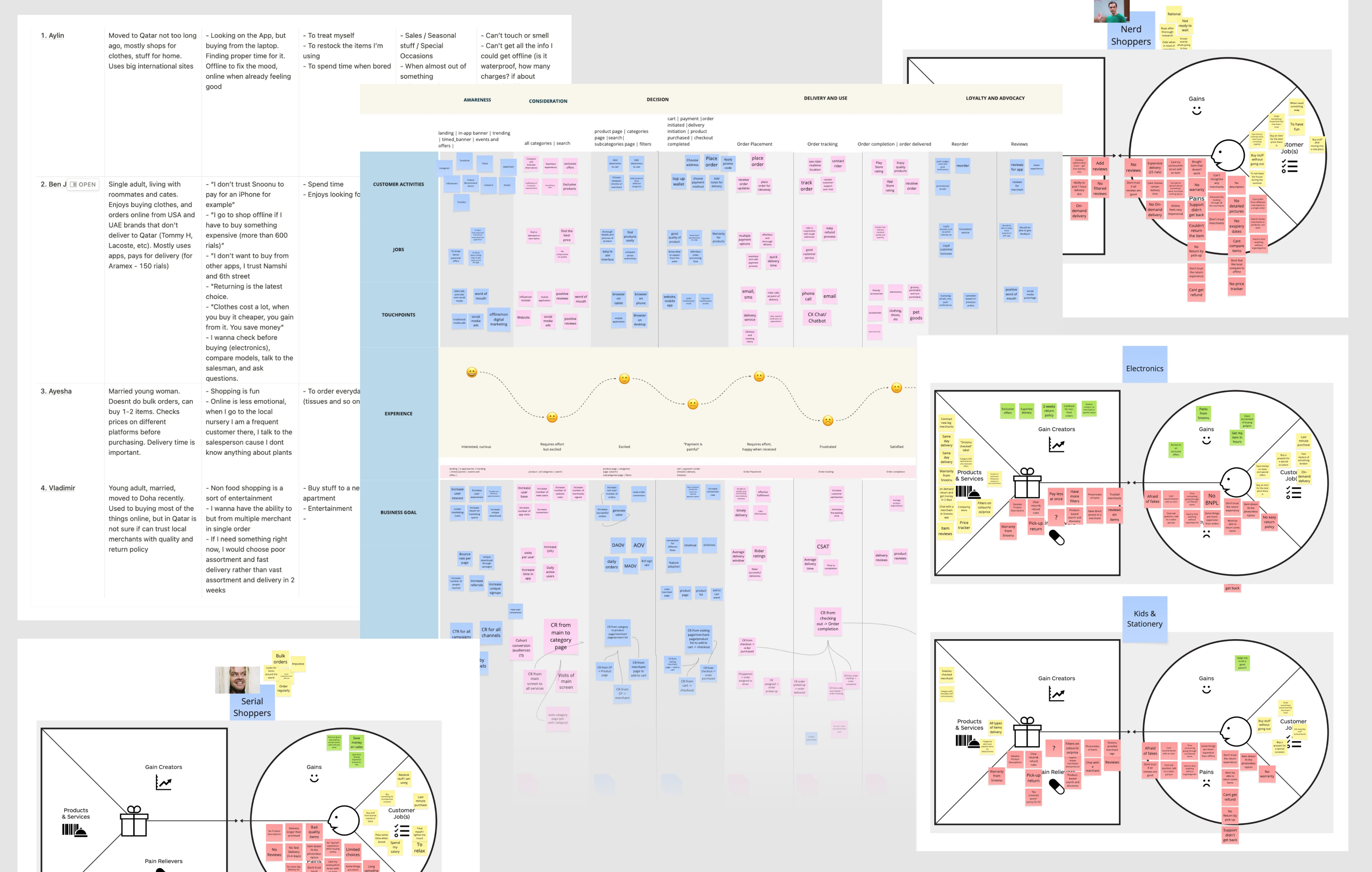
We conducted different types of product research, including user interviews, a CJM, and a pain and gain analysis
Discovery
We worked closely with product, engineering, and business teams to rethink the experience from the ground up. We audited the existing food-first architecture, conducted user research through workshops and interviews, and identified key pain points.
This led to four major areas of focus:
- Item-based catalog: a shared structure to support product-first browsing
- Dedicated marketplace homepage: a clear entry point for discovery
- Advanced search and filters: to improve findability across sellers
- Multi-cart system: to support mixing items from different merchants
Implementation
Over the course of a year, we gradually rolled out the new experience, working closely with cross-functional teams to implement backend updates, introduce new logic, and redesign the UI.
Preparation
We began by mapping out concepts and flows to help backend teams understand the new structure. Once the architecture was aligned, backend teams began implementation, while product and design planned and scoped the next phases.
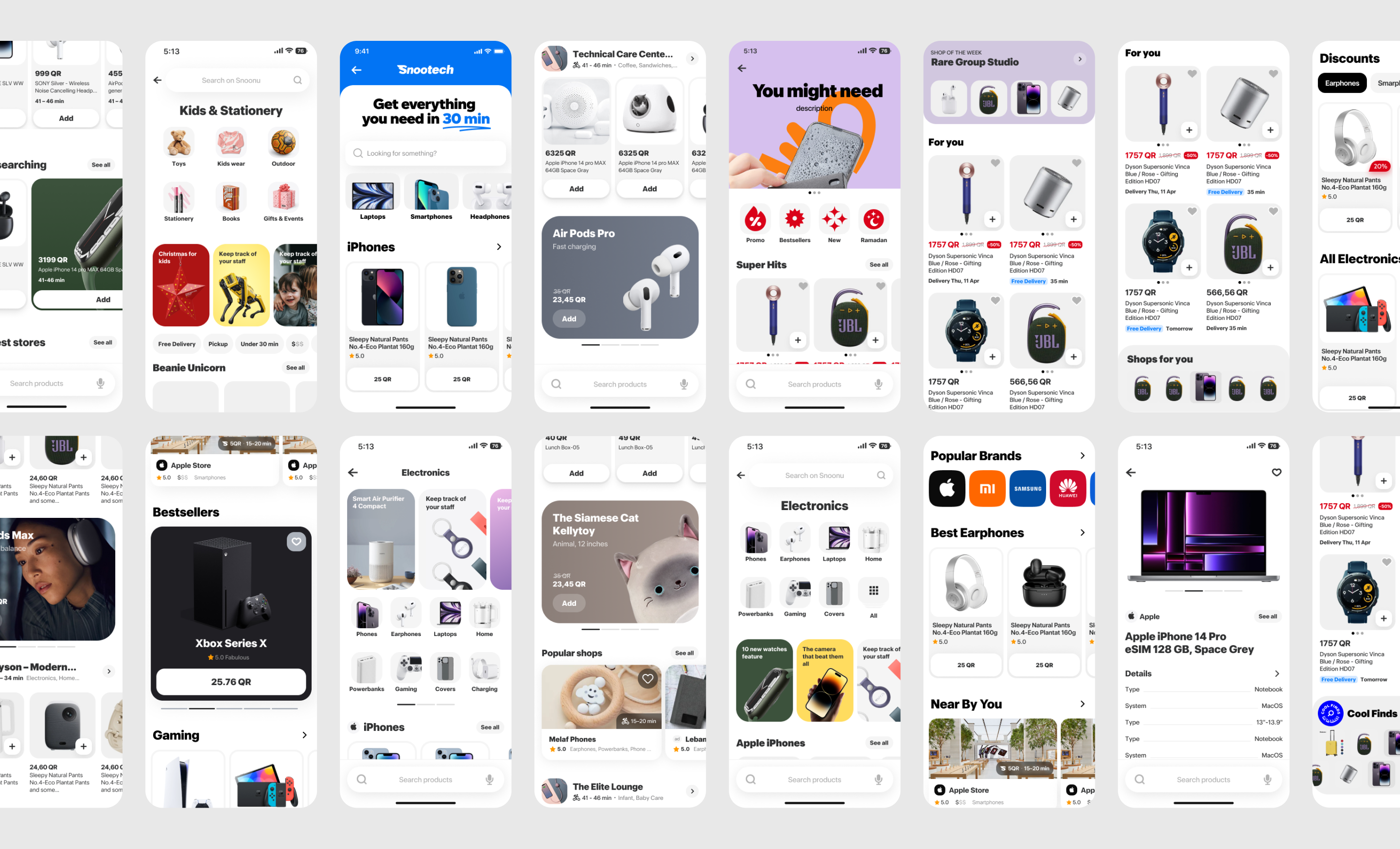
First marketplace concepts
Multicart
Success metric: reduce cart destroy rate.
When we began sketching early concepts, we quickly realized we were blocked by the existing cart logic – it only supported one merchant at a time. Launching the item-based catalog without addressing this would have led users to add products from different merchants, causing the cart to reset each time. This would not only frustrate them but also damage trust and hurt conversion.
The key question became: should we create a new cart specifically for marketplace items or adapt the existing cart to support both food and non-food flows? Or maybe, migrate food into a new, unified cart altogether?
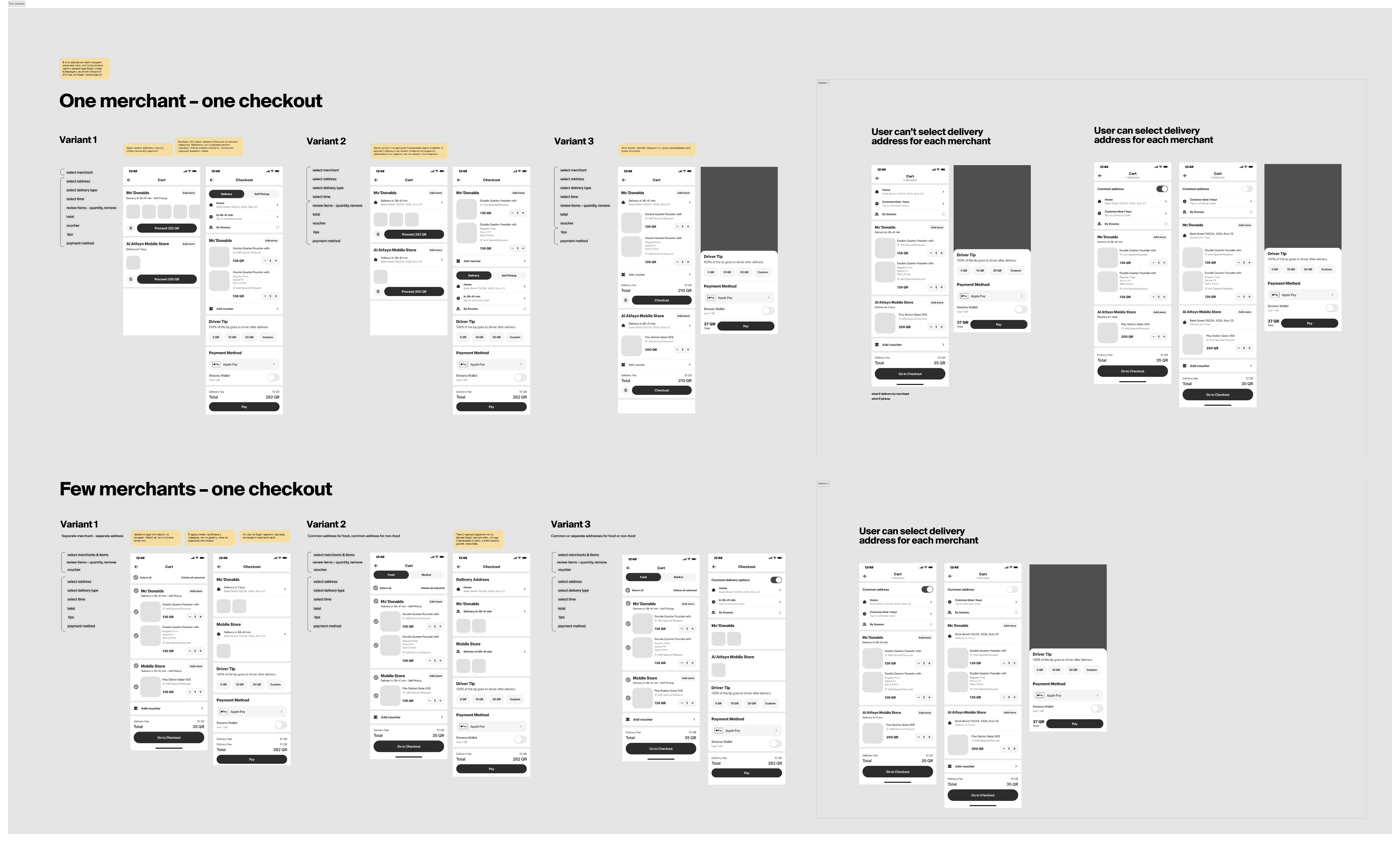
Different approaches for marketplace cart
We explored many directions and eventually concluded that, for business needs and development constraints, the best option was to introduce a new marketplace multi-merchant cart, separate from the food one. This new cart would support multiple merchants and only handle marketplace items.
The next challenge was how to show two carts in the same app without confusing the user. We went with a slider-based solution, where the active cart changes based on the user’s current flow. For example:
- In marketplace categories and search results, the marketplace cart appears first
- In food categories, the food cart is shown first
- Users can always swipe or switch to the other cart if needed
After launch, cart destroy rate dropped, and we were finally able to move forward with building the item-based catalog.
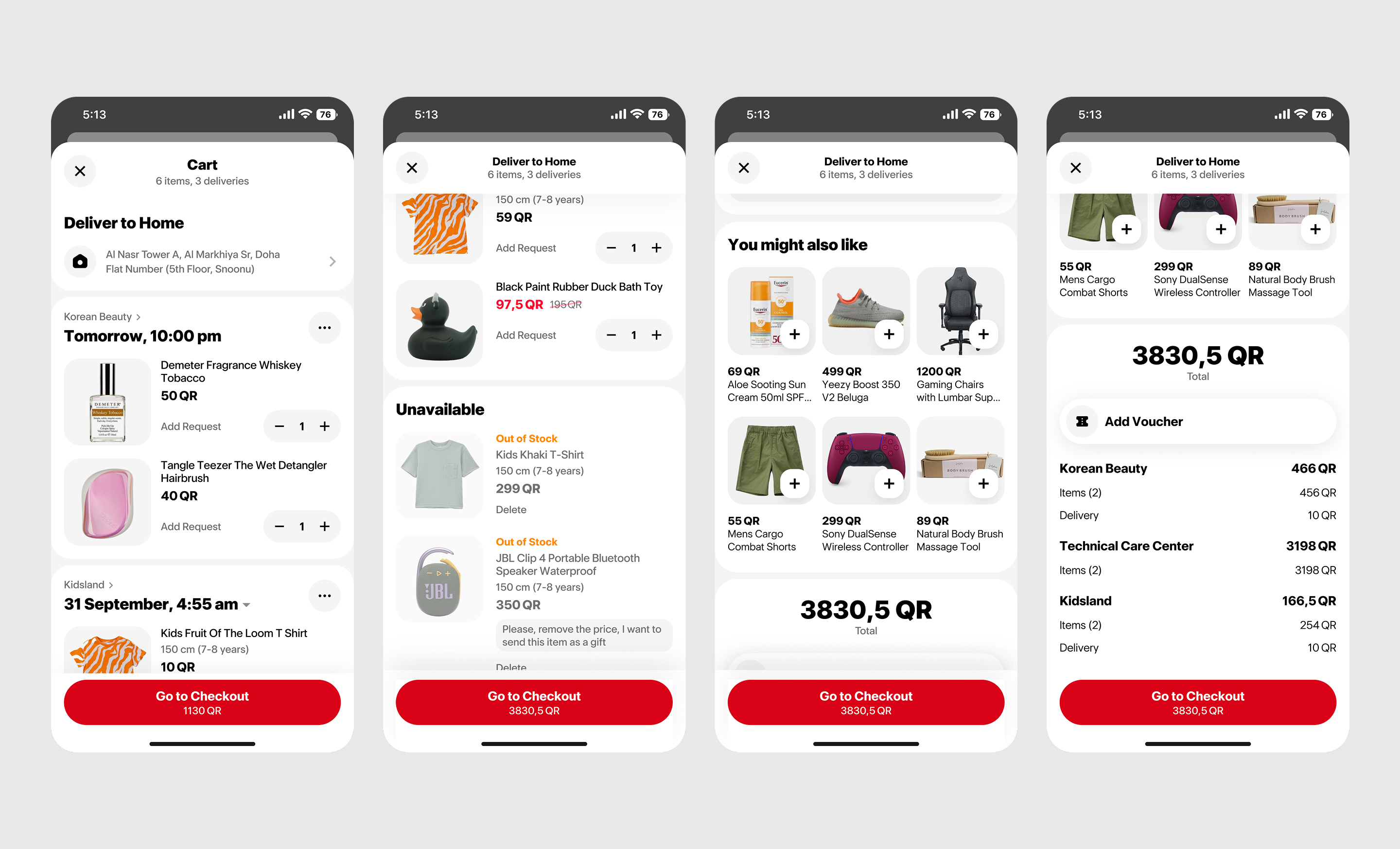
Multi-merchant marketplace cart
Catalog & Filters
Success metrics: Items per order, conversion from marketplace categories to cart
We reviewed all Snoonu categories and restructured those related to the marketplace. Through card sorting and user interviews, we designed a more intuitive hierarchy of categories and subcategories.
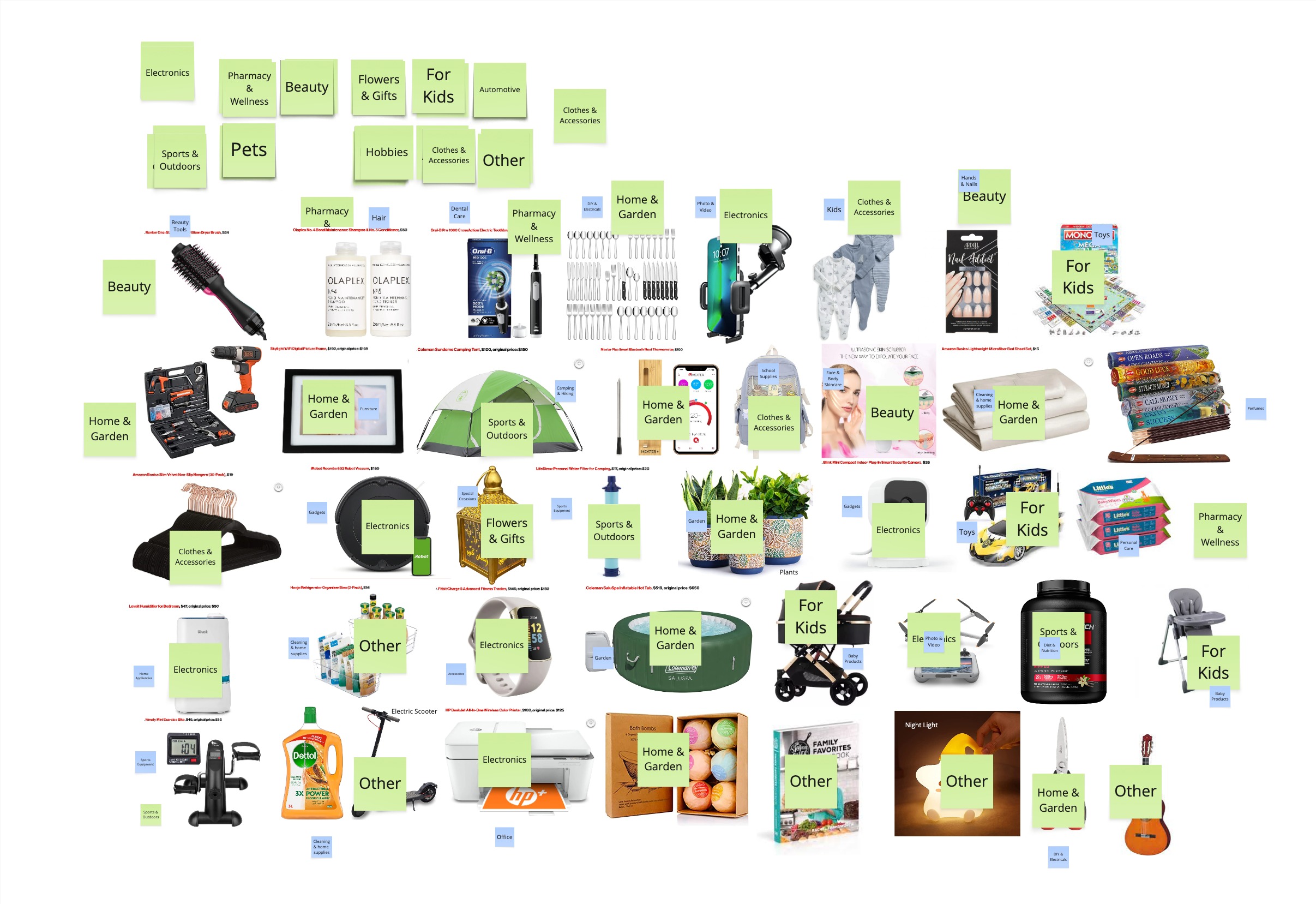
We conducted card sorting to design a more intuitive category structure
Once we finalized the categories and subcategories, and the backend architecture was ready, we moved on to the item-based feed within those categories. Now, if a user selected a food category, they would see merchants (as before). But if they selected a marketplace category, they’d see item listings instead.
When users added products from marketplace categories, they would go into the new multi-merchant cart. At first, we were concerned this dual logic might confuse users, so we explored tagging the categories as “marketplace” to make it clearer. But after a few rounds of testing, we learned that the use cases rarely overlapped – it’s not common for people to shop for burgers and smartphones at the same time.
Within each category, we introduced its own set of subcategories and filters. The item-based structure finally unlocked the ability to filter by price, brand, and other useful attributes.
We saw an increase in conversion and average items per order, as users could now explore products from multiple merchants in one go.
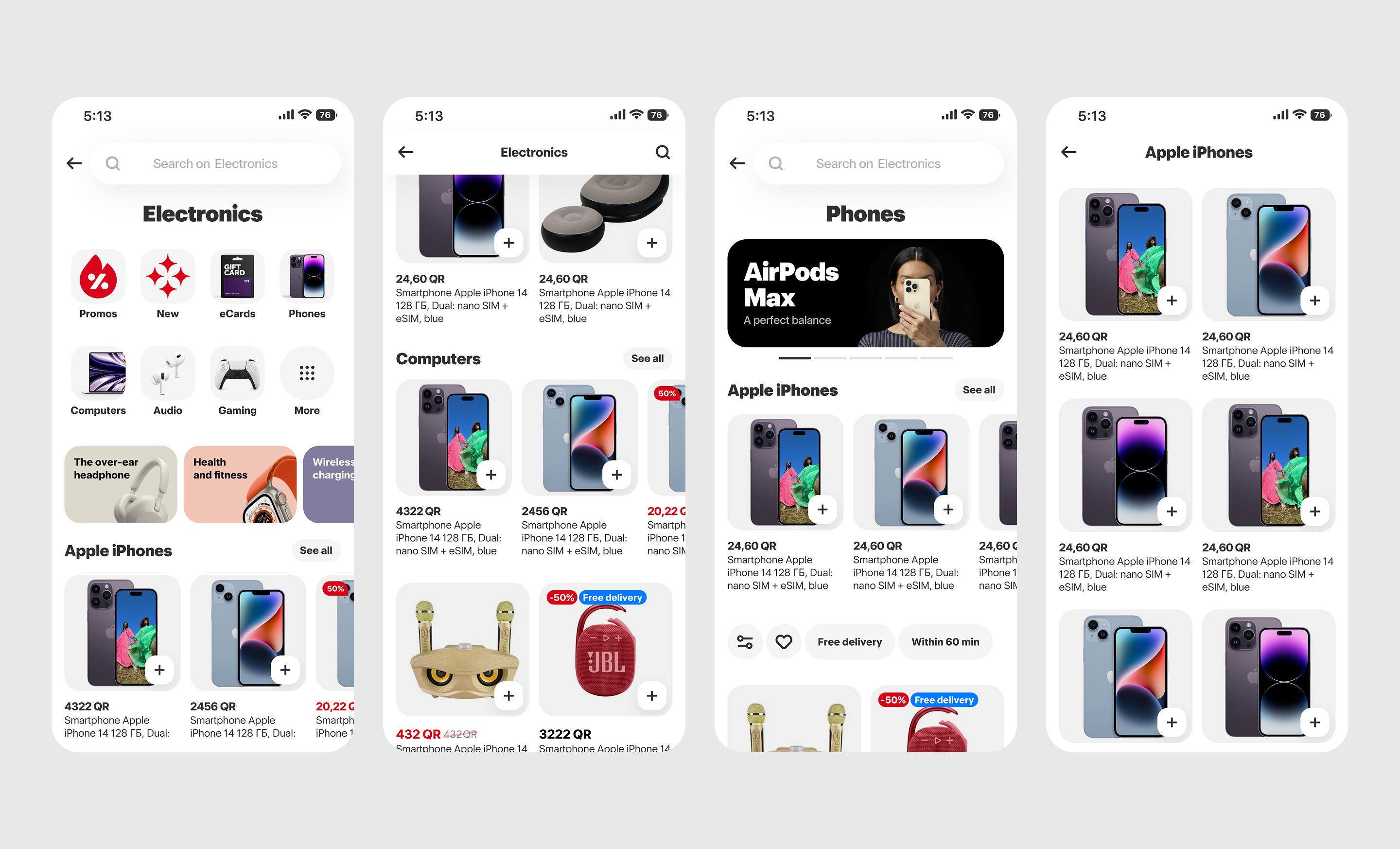
Item listings in marketplace categories
Marketplace Home Page
Once the item-based catalog and dedicated cart were in place, the next step was to define a clear entry point into the marketplace. From both a business and UX perspective, it was important to give the marketplace its own space, separate from the food flow. We also needed a dedicated search experience focused on products rather than merchants.
On the new marketplace homepage, we brought together all the categories that had already been launched. At the top, users see the main marketplace categories with the option to dive into subcategories for more specific browsing. Below that, a personalized product feed appears based on the user’s previous activity, with an option to switch to a popular or promo feed. While we planned to improve personalization over time, this served as the foundation for future iterations.
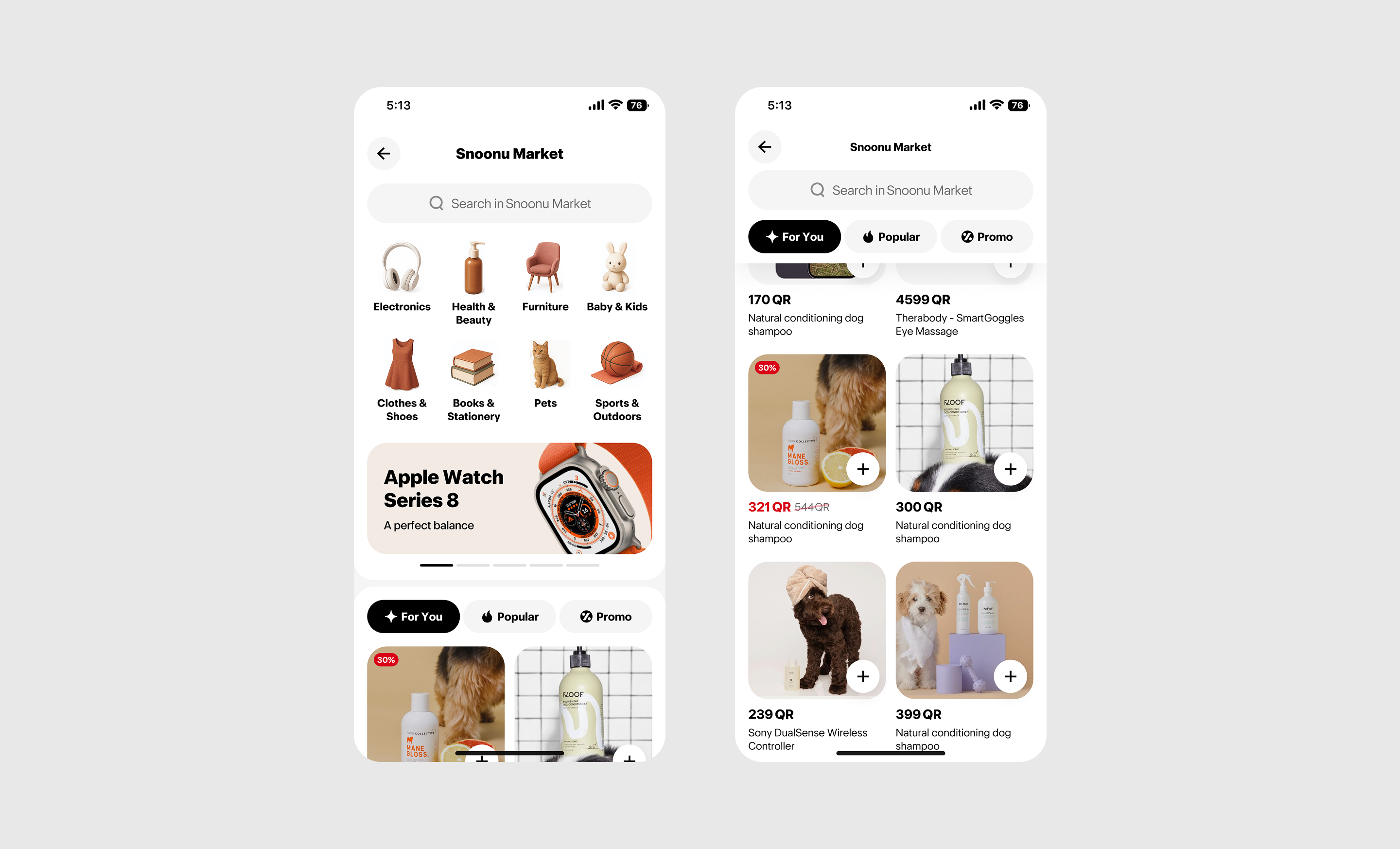
Dedicated homepage with personalized product feed and clear category entry points
Overall Results
By rebuilding the experience around products instead of merchants, we achieved several key outcomes:
- Matched user expectations for how a marketplace should work
- Enabled true multi-merchant shopping
- Made search, filtering, and comparison significantly easier
- Created a scalable foundation for future features
Metrics (1 Year After Launch)
- +1pp overall conversion rate
- GMV (year-over-year) increased by more than 2 times
- Monthly order volume increased by 2 times
What’s Next
After launching the new marketplace foundation, we continued building on top of it with several additional features such as product lists, favorites, an improved version of personalized recommendations, new product page, and more.
Upcoming features
- AI-powered search assistant
- Rating & reviews on the product page
Next Case
S Market: Building a Product-First Marketplace Catalog
Snoonu was originally designed for food delivery. The entire system was built around merchants: each product belonged to a specific merchant, and the cart only supported one merchant at a time. While this worked well for food orders, it didn’t fit non-food shopping behavior.
As the business decided to grow into a full marketplace, we had to rethink how users browse, compare, and shop across multiple sellers. Our goal was to move from a merchant-first to a product-first model.
Problem
What users expected
- To browse by product categories, not by merchant
- To compare similar items from different merchant
- To add products from multiple merchants in one order
- To discover everything available in one place
Why the system couldn’t support this experience
- Search was limited to individual merchants
- The catalog was segmented by store
- The cart reset when mixing products from different sellers
- There was no shared structure to organize and display all products
Goals
Users clearly wanted to compare products, mix items from different merchants, and explore the catalog without friction. To support this, we focused on:
- Enabling search and browsing across all products, not just within a single store
- Allowing users to add items from different sellers to the same cart
- Displaying all available products in one place, so users don’t need to jump between pages
- Laying the foundation for a more flexible and scalable product catalog
- Separating the food flow from the marketplace in a way that feels clear and natural to users

We conducted different types of product research, including user interviews, a CJM, and a pain and gain analysis
Discovery
We worked closely with product, engineering, and business teams to rethink the experience from the ground up. We audited the existing food-first architecture, conducted user research through workshops and interviews, and identified key pain points.
This led to four major areas of focus:
- Item-based catalog: a shared structure to support product-first browsing
- Dedicated marketplace homepage: a clear entry point for discovery
- Advanced search and filters: to improve findability across sellers
- Multi-cart system: to support mixing items from different merchants
Implementation
Over the course of a year, we gradually rolled out the new experience, working closely with cross-functional teams to implement backend updates, introduce new logic, and redesign the UI.
Preparation
We began by mapping out concepts and flows to help backend teams understand the new structure. Once the architecture was aligned, backend teams began implementation, while product and design planned and scoped the next phases.

First marketplace concepts
Multicart
Success metric: reduce cart destroy rate.
When we began sketching early concepts, we quickly realized we were blocked by the existing cart logic – it only supported one merchant at a time. Launching the item-based catalog without addressing this would have led users to add products from different merchants, causing the cart to reset each time. This would not only frustrate them but also damage trust and hurt conversion.
The key question became: should we create a new cart specifically for marketplace items or adapt the existing cart to support both food and non-food flows? Or maybe, migrate food into a new, unified cart altogether?

Different approaches for marketplace cart
We explored many directions and eventually concluded that, for business needs and development constraints, the best option was to introduce a new marketplace multi-merchant cart, separate from the food one. This new cart would support multiple merchants and only handle marketplace items.
The next challenge was how to show two carts in the same app without confusing the user. We went with a slider-based solution, where the active cart changes based on the user’s current flow. For example:
- In marketplace categories and search results, the marketplace cart appears first
- In food categories, the food cart is shown first
- Users can always swipe or switch to the other cart if needed
After launch, cart destroy rate dropped, and we were finally able to move forward with building the item-based catalog.

Multi-merchant marketplace cart
Catalog & Filters
Success metrics: Items per order, conversion from marketplace categories to cart
We reviewed all Snoonu categories and restructured those related to the marketplace. Through card sorting and user interviews, we designed a more intuitive hierarchy of categories and subcategories.

We conducted card sorting to design a more intuitive category structure
Once we finalized the categories and subcategories, and the backend architecture was ready, we moved on to the item-based feed within those categories. Now, if a user selected a food category, they would see merchants (as before). But if they selected a marketplace category, they’d see item listings instead.
When users added products from marketplace categories, they would go into the new multi-merchant cart. At first, we were concerned this dual logic might confuse users, so we explored tagging the categories as “marketplace” to make it clearer. But after a few rounds of testing, we learned that the use cases rarely overlapped – it’s not common for people to shop for burgers and smartphones at the same time.
Within each category, we introduced its own set of subcategories and filters. The item-based structure finally unlocked the ability to filter by price, brand, and other useful attributes.
We saw an increase in conversion and average items per order, as users could now explore products from multiple merchants in one go.

Item listings in marketplace categories
Marketplace Home Page
Once the item-based catalog and dedicated cart were in place, the next step was to define a clear entry point into the marketplace. From both a business and UX perspective, it was important to give the marketplace its own space, separate from the food flow. We also needed a dedicated search experience focused on products rather than merchants.
On the new marketplace homepage, we brought together all the categories that had already been launched. At the top, users see the main marketplace categories with the option to dive into subcategories for more specific browsing. Below that, a personalized product feed appears based on the user’s previous activity, with an option to switch to a popular or promo feed. While we planned to improve personalization over time, this served as the foundation for future iterations.

Dedicated homepage with personalized product feed and clear category entry points
Overall Results
By rebuilding the experience around products instead of merchants, we achieved several key outcomes:
- Matched user expectations for how a marketplace should work
- Enabled true multi-merchant shopping
- Made search, filtering, and comparison significantly easier
- Created a scalable foundation for future features
Metrics (1 Year After Launch)
- +1pp overall conversion rate
- GMV (year-over-year) increased by more than 2 times
- Monthly order volume increased by 2 times
What’s Next
After launching the new marketplace foundation, we continued building on top of it with several additional features such as product lists, favorites, an improved version of personalized recommendations, new product page, and more.
Upcoming features
- AI-powered search assistant
- Rating & reviews on the product page
Next Case
S Market: Building a Product-First Marketplace Catalog
Snoonu was originally designed for food delivery. The entire system was built around merchants: each product belonged to a specific merchant, and the cart only supported one merchant at a time. While this worked well for food orders, it didn’t fit non-food shopping behavior.
As the business decided to grow into a full marketplace, we had to rethink how users browse, compare, and shop across multiple sellers. Our goal was to move from a merchant-first to a product-first model.
Problem
What users expected
- To browse by product categories, not by merchant
- To compare similar items from different merchant
- To add products from multiple merchants in one order
- To discover everything available in one place
Why the system couldn’t support this experience
- Search was limited to individual merchants
- The catalog was segmented by store
- The cart reset when mixing products from different sellers
- There was no shared structure to organize and display all products
Goals
Users clearly wanted to compare products, mix items from different merchants, and explore the catalog without friction. To support this, we focused on:
- Enabling search and browsing across all products, not just within a single store
- Allowing users to add items from different sellers to the same cart
- Displaying all available products in one place, so users don’t need to jump between pages
- Laying the foundation for a more flexible and scalable product catalog
- Separating the food flow from the marketplace in a way that feels clear and natural to users

We conducted different types of product research, including user interviews, a CJM, and a pain and gain analysis
Discovery
We worked closely with product, engineering, and business teams to rethink the experience from the ground up. We audited the existing food-first architecture, conducted user research through workshops and interviews, and identified key pain points.
This led to four major areas of focus:
- Item-based catalog: a shared structure to support product-first browsing
- Dedicated marketplace homepage: a clear entry point for discovery
- Advanced search and filters: to improve findability across sellers
- Multi-cart system: to support mixing items from different merchants
Implementation
Over the course of a year, we gradually rolled out the new experience, working closely with cross-functional teams to implement backend updates, introduce new logic, and redesign the UI.
Preparation
We began by mapping out concepts and flows to help backend teams understand the new structure. Once the architecture was aligned, backend teams began implementation, while product and design planned and scoped the next phases.

First marketplace concepts
Multicart
Success metric: reduce cart destroy rate.
When we began sketching early concepts, we quickly realized we were blocked by the existing cart logic – it only supported one merchant at a time. Launching the item-based catalog without addressing this would have led users to add products from different merchants, causing the cart to reset each time. This would not only frustrate them but also damage trust and hurt conversion.
The key question became: should we create a new cart specifically for marketplace items or adapt the existing cart to support both food and non-food flows? Or maybe, migrate food into a new, unified cart altogether?

Different approaches for marketplace cart
We explored many directions and eventually concluded that, for business needs and development constraints, the best option was to introduce a new marketplace multi-merchant cart, separate from the food one. This new cart would support multiple merchants and only handle marketplace items.
The next challenge was how to show two carts in the same app without confusing the user. We went with a slider-based solution, where the active cart changes based on the user’s current flow. For example:
- In marketplace categories and search results, the marketplace cart appears first
- In food categories, the food cart is shown first
- Users can always swipe or switch to the other cart if needed
After launch, cart destroy rate dropped, and we were finally able to move forward with building the item-based catalog.

Multi-merchant marketplace cart
Catalog & Filters
Success metrics: Items per order, conversion from marketplace categories to cart
We reviewed all Snoonu categories and restructured those related to the marketplace. Through card sorting and user interviews, we designed a more intuitive hierarchy of categories and subcategories.

We conducted card sorting to design a more intuitive category structure
Once we finalized the categories and subcategories, and the backend architecture was ready, we moved on to the item-based feed within those categories. Now, if a user selected a food category, they would see merchants (as before). But if they selected a marketplace category, they’d see item listings instead.
When users added products from marketplace categories, they would go into the new multi-merchant cart. At first, we were concerned this dual logic might confuse users, so we explored tagging the categories as “marketplace” to make it clearer. But after a few rounds of testing, we learned that the use cases rarely overlapped – it’s not common for people to shop for burgers and smartphones at the same time.
Within each category, we introduced its own set of subcategories and filters. The item-based structure finally unlocked the ability to filter by price, brand, and other useful attributes.
We saw an increase in conversion and average items per order, as users could now explore products from multiple merchants in one go.

Item listings in marketplace categories
Marketplace Home Page
Once the item-based catalog and dedicated cart were in place, the next step was to define a clear entry point into the marketplace. From both a business and UX perspective, it was important to give the marketplace its own space, separate from the food flow. We also needed a dedicated search experience focused on products rather than merchants.
On the new marketplace homepage, we brought together all the categories that had already been launched. At the top, users see the main marketplace categories with the option to dive into subcategories for more specific browsing. Below that, a personalized product feed appears based on the user’s previous activity, with an option to switch to a popular or promo feed. While we planned to improve personalization over time, this served as the foundation for future iterations.

Dedicated homepage with personalized product feed and clear category entry points
Overall Results
By rebuilding the experience around products instead of merchants, we achieved several key outcomes:
- Matched user expectations for how a marketplace should work
- Enabled true multi-merchant shopping
- Made search, filtering, and comparison significantly easier
- Created a scalable foundation for future features
Metrics (1 Year After Launch)
- +1pp overall conversion rate
- GMV (year-over-year) increased by more than 2 times
- Monthly order volume increased by 2 times
What’s Next
After launching the new marketplace foundation, we continued building on top of it with several additional features such as product lists, favorites, an improved version of personalized recommendations, new product page, and more.
Upcoming features
- AI-powered search assistant
- Rating & reviews on the product page
Next Case